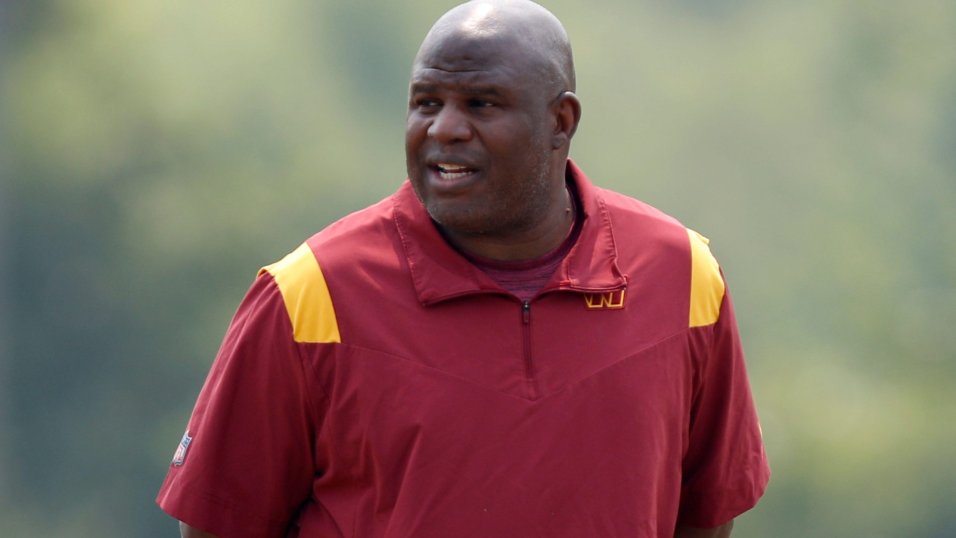- The new look Baltimore Ravens offense: Todd Monken aims to bring more of a passing attack to a typically run-heavy team.
- Eric Bieniemy gets a shot: The Washington Commanders bring in the former Kansas City Chiefs offensive coordinator to call their offensive plays, but how much can we learn from a coach who hasn’t been a full-time play-caller before?
- Aaron Rodgers reunited with Nathaniel Hackett: While not the offensive play-caller in Green Bay, Hackett did give us some takeaways from his time in that role with the Denver Broncos last season.
Estimated reading time: 11 minutes
The NFL coaching landscape looks different every season and as a result, various schemes and play-calling strategies tend to shift for teams, sometimes dramatically. By taking a deeper look at some of the teams with new offensive play-callers, fantasy managers should get a better understanding of what these new coaches’ tendencies are and what that means for fantasy football.
It’s important to note that coaches and schemes are constantly changing and evolving, so while this piece is meant to highlight differences between coaching tendencies, it is by no means a guarantee that teams won’t switch things up from their norm each season. This is only meant to highlight some of the more likely tendency changes that we could see in 2023 under a new coaching staff.
Editor's note: Part 1 of this two-part series covered the Denver Broncos, Indianapolis Colts, Los Angeles Chargers, Dallas Cowboys and Carolina Panthers. It can be viewed here.
Baltimore Ravens — new offensive coordinator, Todd Monken
Looking at some of the biggest differences between Todd Monken's last season as an offensive playcaller in Cleveland versus what the Ravens’ tendencies were under last year’s coaching staff:
| Offensive metric | Monken tendency (2019) | 2022 tendency | Difference for 2023 projections |
| Pass rate | 62.8% | 54.6% | +8.2% |
| Run rate | 37.2% | 45.4% | -8.2% |
| 11 personnel | 56.8% | 12.6% | +44.2% |
| 21 personnel | 5.7% | 24.1% | -18.4% |
| 22 personnel | 0.2% | 33.9% | -33.7% |
| TE target rate | 12.6% | 40.0% | -28.4% |
| WR target rate | 59.0% | 39.5% | +19.5% |
| Quick game + screen pass rate | 32.9% | 22.4% | +10.5% |
The most common assumption about the Ravens’ offense in 2023 under Monken is that it will pass the ball more than in the past after ranking well below average in that regard last season.
The stark difference between pass and run rate was also true for Monken in 2018 with Tampa Bay, as the Bucs ranked third in the NFL in pass rate that season (69.2%), so the offensive shift toward a heavier passing attack certainly seems to check out. The question will be how much it ends up taking away from Lamar Jackson’s designed rushing attempts, and while that should decrease, Jackson has proven to be too much of a weapon in that regard during his NFL career, that it still makes sense to be a part of the offense, just maybe not at the rate of eight or so attempts per game anymore.
With a higher pass rate, the receiving weapons should inevitably get more involved in the offense, which is positive news for Odell Beckham, Zay Flowers and Rashod Bateman, who should all get a chance to be on the field more and see more targets. The Ravens'11 personnel (three wide receivers) rate was far and away the lowest in the league last season, mostly due to the team treating Mark Andrews as its primary slot receiver. While Andrews should continue in that role, it may not be as much as last season. Flowers, Bateman and Beckham could all see time in that spot throughout the season with Andrews either lining up in line or as an additional slot based on Monken’s history. However the usage shakes out for Andrews, he should still be considered a high-end TE1 but now, the Ravens could also be able to support multiple fantasy-relevant wide receivers in addition to Andrews, which has been a struggle for the team in recent years.
New England Patriots — new offensive coordinator, Bill O’Brien
Looking at some of the biggest differences between Bill O’Brien's last couple seasons as an offensive playcaller in Houston versus what the Patriots’ tendencies were under last year’s coaching staff:
| Offensive metric | O’Brien tendency (2019-2020) | 2022 tendency | Difference for 2023 projections |
| RB1 weekly carry rate | 82.7% (2020) | 67.1% | +15.6% |
| 11 personnel | 61.1% | 77.7% | -16.6% |
| 12 personnel | 32.7% | 19.1% | +13.6% |
| WR target rate | 60.4% | 52.4% | +8.0% |
| Slot WR target rate | 41.9% | 30.7% | +11.2% |
| Pass rate | 66.8% | 60.9% | +5.9% |
The Patriots had a bit of a failed experiment with their offensive play-calling last season, and they’ve turned to a former offensive coordinator (2011) in O’Brien, which should create some fantasy-relevant shifts in offensive philosophy from last season.
O’Brien did lean more heavily on the passing game than what the Patriots showed last season, which also led to fewer targets to the running back position and could be a slight detriment to Rhamondre Stevenson, but he’ll have a chance to make up for that in carries. O’Brien had a tendency to deploy his top running back closer to what fantasy managers would expect from a workhorse back than what New England has become known for, which is more of a committee approach. A running back as good and efficient as Stevenson with a greater rushing deployment has the makings of another RB1 season for the New England back.
The Patriots’ offense last season was odd in that it was among the league leaders in 11 personnel but had a relatively low target rate to the slot receiver, which could turn around under O’Brien. While O’Brien’s 11 personnel rate is closer to the league average overall, his tendency to utilize the team’s slot receiver was much greater than New England’s last season, which is a positive sign for JuJu Smith-Schuster, who figures to play the majority of snaps in that role.
With a decrease in 11 personnel under O’Brien, it’s likely that they increase their 12 personnel (two tight ends), which could allow more opportunities for the team’s second tight end, Mike Gesicki, in addition to Hunter Henry. O’Brien’s Houston Texans ranked third in the NFL in pass rate out of 12 personnel from 2019-2020, so targets to the tight end position in New England could also be on the rise if that trend continues.
Los Angeles Rams — new offensive coordinator, Mike LaFleur
Free for 7-days. Subscribe to continue reading and unlock
Already have a subscription? Log In


